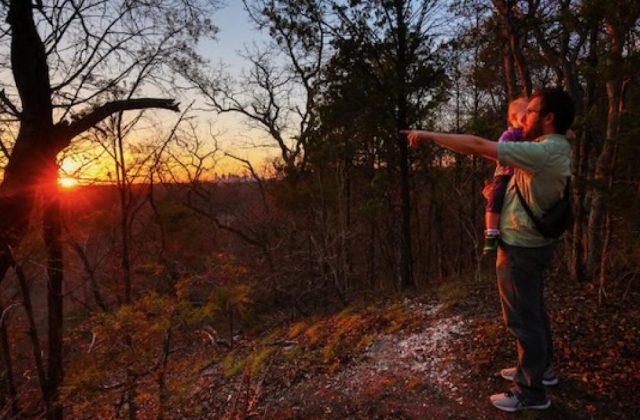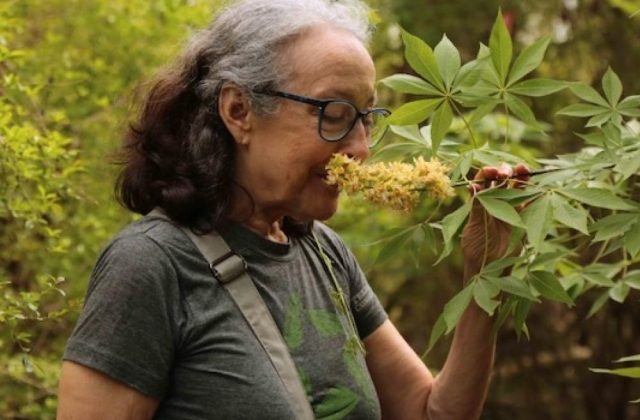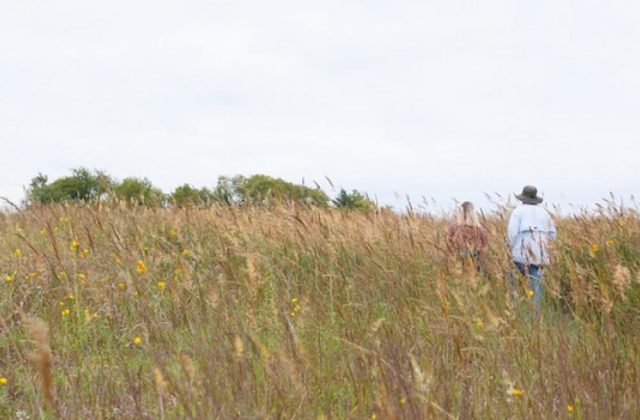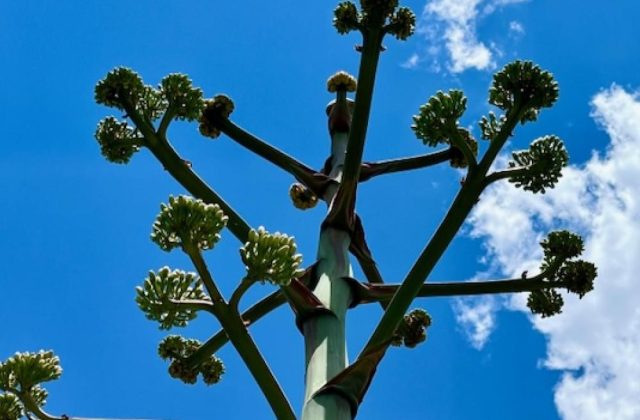Old-growth forest in Garland joins national network
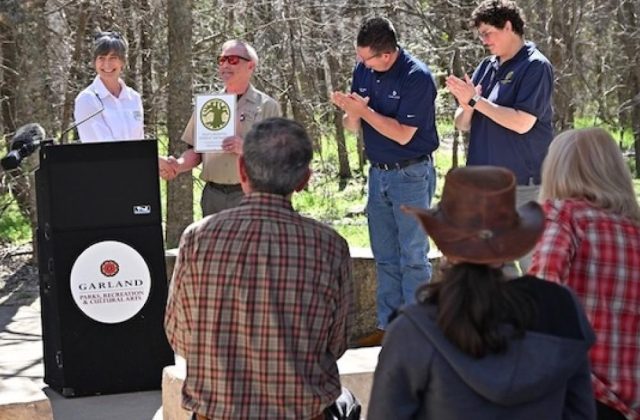
Liz Worsham of the Old-Growth Forest Network, left, presents a certificate to David Parrish of the Preservation Society for Spring Creek Forest as Garland Mayor Scott LeMay and Eric Moore, standing in for County Commissioner Theresa Daniels, look on. Photo by Amy Martin.
Read the original at https://greensourcedfw.org/articles/garland-preserve-inducted-old-growth-forest-network
by Amy Martin – June 19, 2024
The 1800s to early 1900s were tough times for natural spaces in North Texas. Nearly every acre of the Blackland Prairie ecoregion was plowed for agriculture, tilled and seeded with imported pasture grasses, or turned into urban developments, which is why less than one percent of it remains.
Forests met much the same fate for the same reasons. Even the Great Trinity Forest was once mostly leveled for row crops and dairy farms. Old woods clung to existence along rivers and creeks, on ridgetops and floodplains — wherever development or agriculture was unfeasible. West of the Mississippi, less than five percent of the original forest remains. East of the river, it’s under one percent.
That’s why it’s so special when an old-growth remnant is discovered, especially amid DFW’s urban sprawl.
Earlier this year, more than 50 people gathered in Garland to celebrate Spring Creek Forest Preserve‘s admission into the Old-Growth Forest Network. It’s only the second wooded area in Texas to earn the national nonprofit’s recognition.

SAVING SPRING CREEK FOREST
Many acres of what became the 250-acre Spring Creek Forest Park and Preserve in Garland was spared the axe and plow thanks to the land-owning family of Anne C. Weary.
Now an established artist, Weary has courted the woods for artistic inspiration since she was a young girl. Weary loved riding horses and being in nature, spending hours and hours exploring the forest and prairie.
The land containing SCFP benefitted from Spring Creek’s steady flow and occasional bank-jumping flood, which kept the soils moist and the trees healthy, allowing for steady, strong growth. Some heralded the forest as a “biological museum” for its rare combination of trees, especially oaks, many well over a century old.
Desperate to ensure preservation of the extended forest around their land, Weary’s parents reached out to famed Dallas environmentalist Ned Fritz, a family friend, in the late 1970s. Bobby C. Scott, a self-taught Garland naturalist with a passionate love of the forest from childhood, had done the same. The two appeared before the Garland City Council, pleading for the forest’s preservation.
Fritz called in experts from The Nature Conservancy, Texas Parks & Wildlife, Southern Methodist University and others to affirm the forest’s uniqueness and importance.
Weary’s aging parents sold their land to ultimately become part of SCFP, now owned by the city of Garland and Dallas County Open Space. Supporters of the forest continued to grow, and the Preservation Society for Spring Creek Forest was formed. Volunteers, working closely with the Garland Parks and Recreation Department, expended many years and much effort to restore the land from indignities suffered when it was quarried for limestone and used for illegal dumping. Invasives removal and prairie restoration began and continue. Trails were constructed.
National Old-Growth Forest Network Adds Garland Treasure
When the Old-Growth Forest Network solicited sites with original woods to certify in Dallas County, the Preservation Society stepped up. Now SCFP is one of only two sites in Texas recognized by the Network for being healthy, old-growth forests, the first being inside Fort Worth Nature Center and Refuge.
“We’re honored to recognize this forest and the critical partnerships between Dallas County, the city of Garland, the Preservation Society for Spring Creek Forest and the many individuals who continue to work hard to protect, care and educate about this special place,” said Nick Sanchez, Old-Growth Forest Network manager, in a blog post.
OLD-GROWTH DEDICATION
In late February, the Spring Creek Preserve’s pavilion percolated with happiness and pride on the day of the Old-Growth dedication by the Maryland-based nonprofit. The nature jewel of Garland being honored by a national enterprise was a certified big deal to the city. Garland mayor Scott LeMay and other city representatives spoke proudly of their efforts to save the forest. Erin Moore, representing Dallas County Commissioner Dr. Teresa Daniel, also shared a few words for the occasion.

David Parrish of the Preservation Society spoke of their volunteers’ mutually supportive relationship with the city and county. Tom Frey followed up with a geological and naturalist history of the preserve.
Weary, whose artwork from the preserve was on display at Garland’s Granville Art Center, moved attendees with her childhood tales of the land. She saluted Ned Fritz’s efforts and urged all present to become defenders of the forest.
Wrapping it up was the presentation by Old-Growth Forest Network board member Liz Worsham, exhorting the crowd to protect this rare arbor gem and any other remnants of America’s great forests.

FEELING THE FOREST
To truly honor a forest, one must experience it. So after the ceremony most of the crowd took a celebratory walk on the preserve’s dirt trails through some of the oldest and largest trees in the county. The Old-Growth dedication coincided with the Preservation Society’s popular Trout Lily Walk, an annual hunt for the delicate wildflower that flourishes in the forest. So society volunteers were on hand to offer impromptu talks on the preserve’s geology and ecology at various stations.
It was a grand trek.
The towering trees, still leafless from winter, stippled the ground with the shadows of limbs. The bright light set the translucent light-green emerging leaves of coralberry shrubs and other plants aglow, creating a radiant understory.

In this hardwood relic forest, trees one to three centuries old soared to heights of 100 feet on trunks four feet thick. Five oak species reside in the forest, including chinquapin, bur and Shumard, a combination found in few other places. Joining them are astoundingly tall green ashes and sycamores and massive black walnuts.
The canopy tittered with the laughing cackles and piercing “skee-ews” of northern flickers in conversation. Blue jays rummaged for nuts beneath towering pecans with delightfully shaggy bark. The twitter of chickadees and buzz of titmice was omnipresent.
ON THE HUNT FOR OLD GROWTH
As the Dallas County representative for the Old Growth Forest Network, I’m to search for other old-growth remnants in the county. Following a tip by the Texas Historic Tree Coalition, most of the entire Piedmont Ridge was exhaustively explored.

Aerial photos from the early 1900s show concentrations of massive trees on the ridge, now mostly lost to development. On a hike with Wild DFW photographer Daniel Koglin, we spied a tantalizing old-growth remnant off Scyene from the ridge’s high spot north of Gateway Park.
Hiking a trail, possibly made by Boy Scouts in the 1970s, an elder forest of immense trees beckoned. But as we approached, Koglin’s spidey senses, honed by decades working in military situations, fired off and we rapidly backtracked. We later learned we’d stumbled into a large encampment known for its violence and illegal activities.
Such a shame! Beyond it was one of the most majestic forests I’d seen in Dallas County — dense with substantial trees and cast in perpetual twilight. The understory was seemingly healthy and free of major privet infestation.
A few weeks later, I explored parts of the Great Trinity Forest with Dallas Parks and Recreation ecological professionals Brett Johnson and Chris McMaster. We checked out areas near Dallas County Open Space preserves Joppa and McCommas Bluff, off the paved Trinity Forest Trail. We found scattered patches of old trees, but not quite old-growth forest.

Confluences, with their tendency to flood, sometimes harbor old growth. Before that, I hiked with Jeff Brown of North Texas Trails on a new trail under development, off the end of the soft-surface Ned and Genie Fritz Texas Buckeye Trail. The new trail leads through Great Trinity Forest to the White Rock Creek confluence, west of the Trinity River. The same confluence is accessible from the east via the Holland Trail off the end of Elam Road. (More information on the Holland Trail can be found in Wild DFW and on Outdoor Explorer Texas, which has a better map of the spur.)
Patches around the confluence had promise with very large trees but lacked the ecological markers of an old-growth forest. The search for groves of arbor elders in Dallas County will continue! Leave your tips on the Wild DFW website.
RESOURCES
Learn more about the Spring Creek Nature Preserve in its own chapter in Amy Martin’s book Wild DFW: Explore the Amazing Nature Around Dallas-Fort Worth published by Timber Press.
RELATED ARTICLES
Fort Worth forest remnant receives national recognition
Spring Creek Forest preserves ‘biological museum’ in Garland
Stay up to date on everything green in North Texas, including the latest news and events! Sign up for the weekly Green Source DFW Newsletter! Follow us on Facebook, X and Instagram. Also check out our new podcast The Texas Green Report, available on your favorite podcast app.
